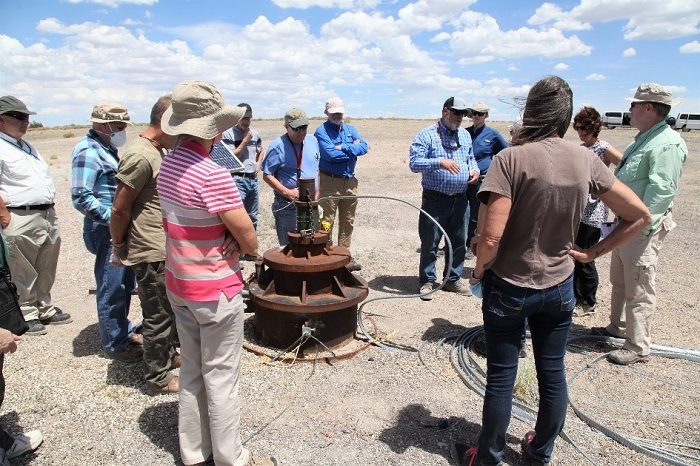 Peer reviewers observe a well at the Pahute Mesa groundwater area at the Nevada National Security Site.
LAS VEGAS – Four peer reviewers recently joined the EM Nevada Program in Las Vegas to participate in technical briefings, presentations and a tour of the Pahute Mesa groundwater region at the Nevada National Security Site (NNSS).
The nationally recognized experts will examine the computer modeling approach developed to forecast groundwater movement and contaminant boundaries in the Pahute Mesa region. To promote stakeholder involvement, members of the Nevada Site Specific Advisory Board and representatives from Nye County and the Nevada Division of Environmental Protection participated in the events with the peer review team.
Under review is the Pahute Mesa Flow and Transport Model Report — a set of conclusions based on complex geologic and mathematical models of groundwater flow and contaminant transport. Over 30 years of intensive drilling, data collection, analysis and modeling went into the making of the model. Scientists with the EM Nevada Program use such models to analyze the movement of radioactive contaminants in groundwater at the NNSS.
 Underground Test Area Project Manager Ken Rehfeldt addresses the group of peer reviewers at Oasis Valley at the Nevada National Security Site.
“We were thrilled to welcome the peer review team to review our newest models and observe our work in the field,” said Ken Rehfeldt, Underground Test Area project manager for Navarro Research and Engineering, the environmental program services contractor to the EM Nevada Program. “These models simulate groundwater movement under a wide range of variables and permutations, and they are extremely valuable in ensuring our communities are safe and secure for generations to come.”
The peer reviewers represent the fields of geochemistry, hydrology, hydrogeology and computer modeling. They have expertise in using scientific results to make regulatory decisions.
The reviewers gathered for the first two days of their four-day visit with the EM Nevada Program in the Molasky Center in Las Vegas. They heard presentations and participated in discussions surrounding the Pahute Mesa region, the last open groundwater correction action units at the NNSS. Experts from the EM Nevada Program presented their findings and projections for groundwater movement.
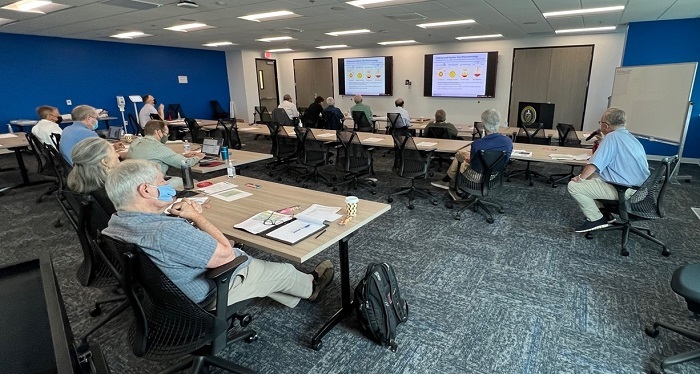 The peer reviewers listen to presentations from the EM Nevada Program at the Molasky Center in Las Vegas on the second day of their four-day visit.
On the third day, the group toured Pahute Mesa and a small portion of the Nevada Test and Training Range. On the fourth day, the group traveled to Oasis Valley, observing the principal discharge area for the groundwater basin and notable geological formations, well sites and monitoring activities in this area.
Current research and modeling forecasts show the contaminated groundwater will not reach public water supplies. In 2020, the Rainier Mesa and Yucca Flat groundwater corrective action areas reached closure, successfully bringing 75% of all NNSS groundwater regions to end-state completion.
The panel will review the model and generate a final report with their findings and assessment of confidence by the end of September.
-Contributor: Grant Johnson
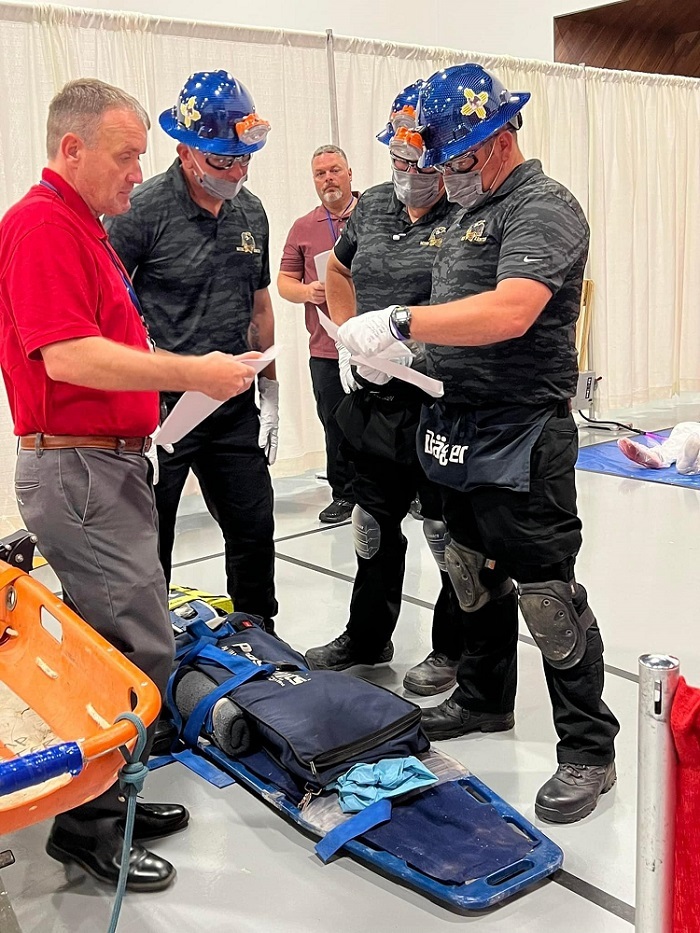 Members of the Waste Isolation Pilot Plant Red Mine Rescue Team prepare to administer first aid to a mock patient during a recent national mine rescue competition in Lexington, Kentucky.
LEXINGTON, Ky. – Mine rescue teams from EM’s Waste Isolation Pilot Plant (WIPP) finished in the top 15 in both the overall and field competitions at the first-ever joint Coal, Metal and Nonmetal National Mine Rescue Contest in Lexington, Kentucky.
More than 40 teams representing coal mines competed in the Aug. 7-12 competition, as well as 22 metal and nonmetal mine teams. WIPP’s teams were among the nonmetal mine teams participating in the event.
The combination competition, or overall, merges the scores from all of the disciplines — first aid, technical equipment and field competition — of the contest and ranks the teams overall. The WIPP Red team placed 8th overall and the Blue team placed 15th overall out of the 60-plus teams.
In the field competition, the WIPP Red team finished 10th and the Blue team finished 15th.
The federal Mine Act requires that every underground mine operator ensures the availability of rescue teams. Mine rescue contests and simulations are essential to the training process.
The WIPP volunteer team members are employees of Nuclear Waste Partnership, the site’s management and operating contractor.
“These employees spend numerous hours outside their normal workday responsibilities refining their knowledge and skills associated with mine rescue operations,” said Sean Dunagan, NWP president and project manager. “We are incredibly pleased to have such high-caliber employees that stand ready to provide emergency response in the event of a mine disaster.”
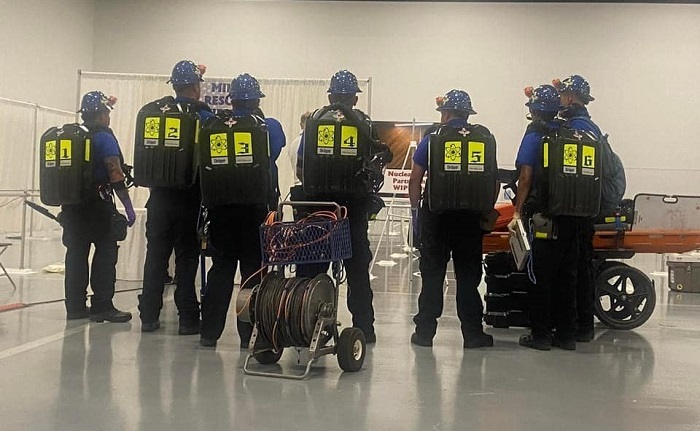 The Waste Isolation Pilot Plant Blue Mine Rescue Team participates in a final briefing before beginning a field contest in a recent national mine rescue competition.
In the team technician contest, two-person teams are tasked with repairing and calibrating gas instruments, then taking air readings and calculating the results. WIPP’s Blue technician duo, Colton Ridgway and Chris Dominguez, had a perfect score of zero discounts and finished 4th in the competition, nudged out of a third-place tiebreaker based on time. The Red technician team, Chris Smith and Tony Mihelic, finished 8th with three discounts. All four of WIPP’s contestants had perfect written test scores.
In the first aid contest, teams are presented with a scenario and a simulated patient. They are judged on their first aid skills and CPR techniques. The Red team of Ty Zimmerly, Mark Long, Jr. and Cody Burke finished 14th and the Blue team of Manny Marquez, Misty Long and Lucas Hiner placed 16th.
In another competition, individuals compete by repairing and bench testing a breathing apparatus. The WIPP teams entered four contestants in this contest. Hank Miller of the WIPP Red team finished 5th, Lucas Hiner of the Blue team placed 13th, Zack Harrell of the Blue team finished 14th and Justin Medina of the Red team placed 24th out of 74 contestants from both coal, metal and nonmetal teams.
The trainers for the WIPP mine rescue teams are Mathew Ridgway and Francesca Bishop.
The WIPP Red team consists of Mark Long Jr, Chris Smith, Ty Zimmerly, Justin Medina, Hank Miller, Lance Turnbow, Tony Mihelic, Cody Burke, Terry Grube and John Fernandez.
Members of the WIPP Blue team are Lucas Hiner, Colton Ridgway, Misty Long, Manny Marquez, Cole Kessler, Chris Dominguez, Ryan Boatman, Zack Harrell and Nico Dominguez.
-Contributor: Roy Neese
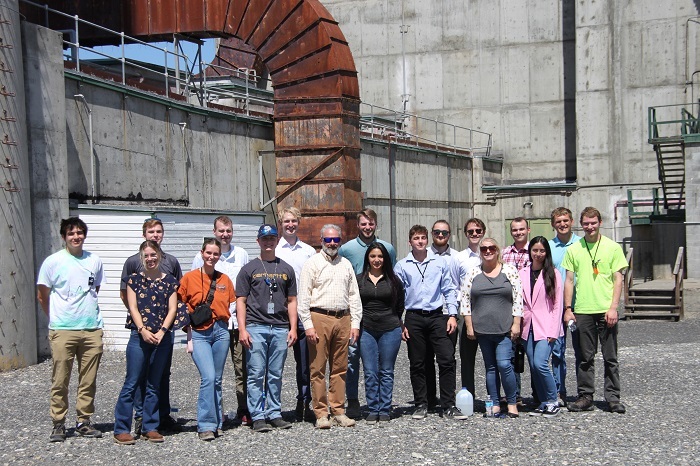 Central Plateau Cleanup Company President John Eschenberg, center, welcomes this year’s summer interns and cooperative education program students to the historic B Reactor on the Hanford Site.
RICHLAND, Wash. – EM Richland Operations Office (RL) contractor Central Plateau Cleanup Company (CPCCo) hosted 20 college interns and cooperative education students this summer as part of an initiative to build and inspire the future workforce.
The internship program offers local students employment opportunities at the Hanford Site while they earn a degree, preparing them for potential careers in the nuclear cleanup industry.
“It has been really beneficial for me to get hands-on experience working alongside some incredibly smart and talented people,” said Evelyn West, an intern at CPCCo. “The highlight of my time is all the staff members willing to train and take you under their wings.”
Program participants work a one-year internship — part time during the school year and full time in the summer — in areas such as engineering, finance and project management. CPCCo is working on a formalized agreement with Columbia Basin College and Washington State University Tri-Cities to grow and foster the co-op program.
“One of the highlights for me has been building and growing my network of relationships,” said intern Alexis Solorio. “On top of that, I’m getting to work with specialized industry software, so there’s a nice balance of book learning in the classroom coupled with actual field experience when I’m on the job.”
Recently, program participants got a chance to see the historic B Reactor. The facility is the world's first full-scale plutonium production reactor and part of the Manhattan Project National Historical Park. There, they learned about the role the reactor played in producing plutonium for national defense during World War II and the Cold War and observed the work CPCCo is doing to preserve the facility for safe public access and educational opportunities.
“The one thing from the B Reactor tour that stood out to me the most was learning about how quickly the entire project came together,” said Michael Wymore, a CPCCo engineering intern. “They were able to build something that had never been done before and have it operational in less than 18 months — it’s an amazing feat.”
Intern Bryce Bean’s parents are long-time Hanford employees, so he is familiar with the work at the site. But something about Bean’s experience at B Reactor hit home with him.
“Seeing the reactor face for the first time, I was just wowed,” said Bean. “And to think this is what started it all! I’ve read about it, but to see it up close and in person is something quite different. You really get the sense of how important this mission was to this community and the entire country. It also helped me see why the cleanup is so important. It feels great to be part of something so meaningful.”
-Contributor: Rob Roxburgh
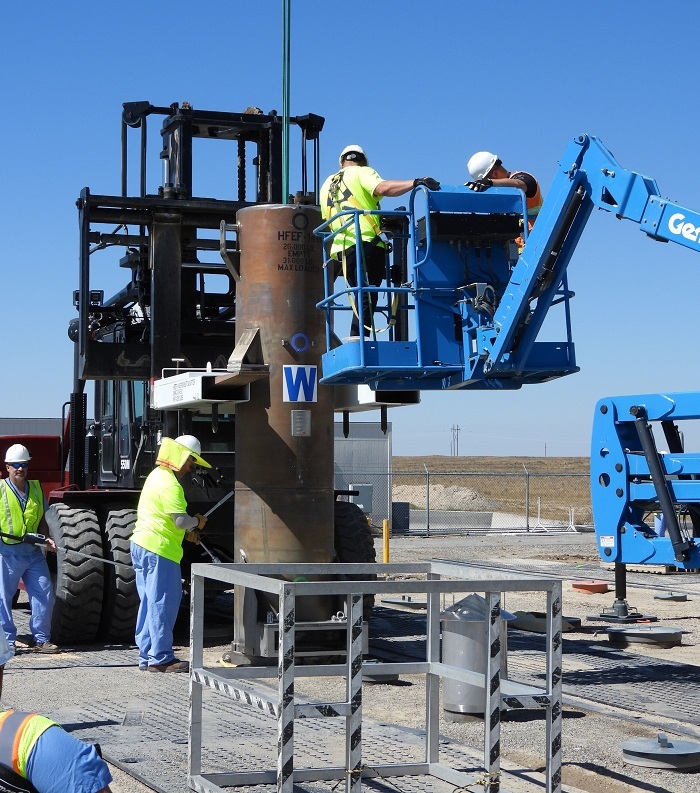 EM crews deposit the 100th shipment of Experimental Breeder Reactor-II spent nuclear fuel into a vault at the Radioactive and Scrap Waste Facility.
IDAHO FALLS, Idaho – EM crews at the Idaho National Laboratory (INL) Site are making significant progress to reduce risk through two projects involving spent nuclear fuel in support of a 1995 agreement with the State of Idaho.
EM cleanup contractor Idaho Environmental Coalition (IEC) reached a milestone to complete six of 39 spent nuclear fuel transfers about two months ahead of schedule. The fuel canisters had been shipped from Pennsylvania to the INL Site following the closure of the Peach Bottom Atomic Power Station, Unit 1 in 1974. The canisters were placed in vaults at Idaho Nuclear Technology and Engineering Center (INTEC).
The early completion of the six fuel transfers was attributed to an efficient, well-managed work pace, and continuity of operations across INTEC.
Due to concerns of corrosion to the fuel canisters, EM crews last year began transferring the Peach Bottom fuel from old vaults to new vaults that provide better storage.
Under the agreement with Idaho, EM is required to transfer all spent nuclear fuel at the INL Site from wet storage to dry storage by Dec. 31, 2023.
In the second project, EM crews are advancing their mission to ship remaining Experimental Breeder Reactor-II (EBR-II) spent nuclear fuel from the DOE complex’s largest spent nuclear fuel storage basin, located at INTEC, to dry storage at the Radioactive Scrap and Waste Facility (RSWF) or the Fuel Conditioning Facility (FCF) at the Materials and Fuels Complex (MFC).
Earlier this month, that project completed the 100th shipment of EBR-II fuel to the RSWF, adding to the project’s total of 168 fuel shipments. Only 31 more shipments of EBR-II fuel to RSWF and FCF remain to empty the basin and reach the milestone under the agreement.
“The EBR-II transfer progress has only been made possible by the collaboration between IEC and Battelle Energy Alliance,” said Kerry Oltmanns, IEC spent nuclear fuel projects manager at INTEC. “The employees of these two companies have a great respect for the mission and it shows every step of the way.”
Battelle Energy Alliance is a DOE Office of Nuclear Energy contractor.
The EBR-II operated at the former Argonne National Laboratory-West, now the MFC, from 1964 until 1994. The reactor generated power for the INL and provided reactor research benefits. Spent nuclear fuel from EBR-II was transferred to wet storage at Chemical Processing Plant-666 from 1986 to 1999.
Oltmanns said despite Idaho weather challenges, it’s impressive that both projects have continued to beat their milestones.
“Our employees always find a way to remain safe and still get the work done despite what Mother Nature throws at them,” she said.
Ken Brewer, IEC INTEC nuclear operations director, said the importance of the Peach Bottom and wet-to-dry storage projects cannot be overstated.
“The progress these two projects have made since March of this year is attributed to great leadership by all involved,” Brewer said.
-Contributor: Erik Simpson
Using a 360-ton crane, crews lift a concrete shielded container of waste from its location near the Main Plant Process Building onto a flatbed trailer. A total of eight concrete shielded waste containers will be overpacked and shipped offsite for disposal.
WEST VALLEY, N.Y. – EM workers safely relocated eight concrete shielded waste containers away from a location near the Main Plant Process Building at the West Valley Demonstration Project (WVDP), clearing the way for the upcoming demolition of the facility, an EM 2022 priority.
EM and cleanup contractor CH2M HILL BWXT West Valley (CHBWV) recently finished moving the waste cannisters within concrete shield containers, each ranging in weight from 68,000 to 80,000 pounds.
“This accomplishment allows us to continue preparations for the future deconstruction of the Main Plant Process Building,” EM WVDP Main Plant Demolition Project Director Stephen Bousquet said. “The completion of this work clears the way for equipment operators to perform a safe and controlled deconstruction of the Main Plant.”
Each container holds water filtering materials from the water treatment system at the former fuel receiving and storage facility. That building received and stored spent nuclear fuel during fuel reprocessing operations at the site from 1966 to 1972.
A flatbed trailer backed into the Main Plant demolition area to retrieve the containers. Using a 360-ton crane, workers moved the containers onto the trailer. Once secured, the vessels were moved to another location on the site.
The concrete shielded containers — and their inner waste receptacles — will be loaded into overpacks approved by the U.S. Department of Transportation and shipped offsite for disposal.
“Our team continues to use their combined knowledge to safely and deliberately complete high-risk work activities,” CHBWV Waste and Site Operations Manager Peggy Loop said. “I’m proud of their efforts and accomplishments, and the work they continue to do on this project.”
-Contributor: Joseph Pillittere
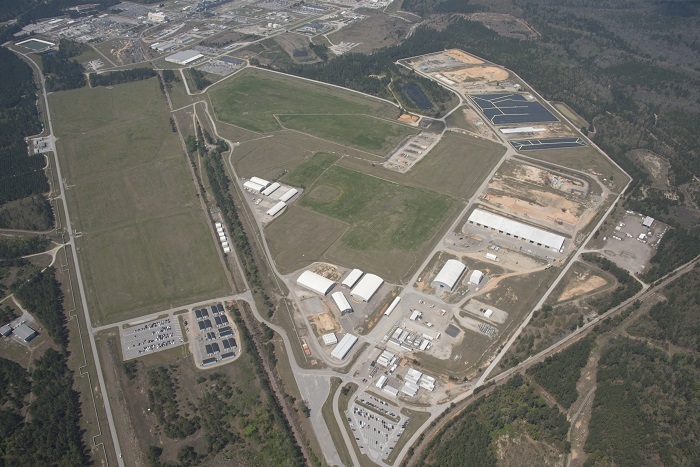 The Solid Waste Management Facility at the Savannah River Site.
AIKEN, S.C. – The Savannah River Site (SRS) Solid Waste Management Facility (SWMF) recently improved the quality of the procedures used to carry out its missions with its Procedure Enhancement Program, leading to increased efficiency for the facility.
“In 2015, SWMF recognized several inadequacies in the performance of procedure reviews,” said Verne Mooneyhan, SWMF facility manager for Savannah River Nuclear Solutions (SRNS), the managing and operating contractor at SRS. “We designed the Procedure Enhancement Program to address these inadequacies and ensure we had a clear set of steps to follow from this point forward.”
SWMF employees reviewed 140 procedures to ensure they reflected current missions and were written to minimize potential errors. The review resulted in the removal of 32% of the procedures that no longer supported SWMF missions. Employees also combined similar procedures, and eliminated unnecessary steps without impacting safety precautions.
“We utilized small group sessions to help identify additional procedural shortcomings for inconsistencies, wording and sequence flow,” said Renee Hoeffner, SRNS SWMF deputy operations manager.
Hoeffner said team members used the same process to review each procedure. To ensure consistency, they developed a checklist used to draft procedure revisions. The revisions were reviewed by subject matter experts before they were routed to a procedure writer. Management conducted a final review prior to implementation.
SWMF implemented training for personnel taking part in the review. It covered expectations for procedure development, review and validation; procedural requirements; and the impact of human factors in procedure development, review and validation.
“SRNS is constantly looking for ways to improve our processes and reduce risks,” said Janice Lawson, SRNS senior vice president of environmental management operations. “I applaud SWMF’s self-identification of an issue and their resolution and persistence in not only getting it fixed, but in improving the process as well.”
The Solid Waste Management Program at SRS is responsible for the disposition of the site’s solid waste, which includes sanitary, construction and demolition, hazardous, low-level radioactive, and transuranic wastes.
-Contributor: Lindsey MonBarren
|